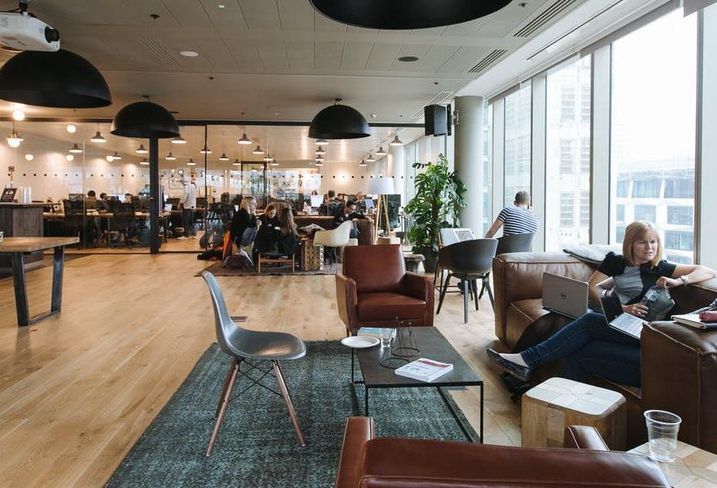WeWork’s Largest Markets Brace For IPO Impact

August 28, 2019 | Mike Phillips and Miriam Hall
LONDON and NEW YORK — In 2010, the biggest office tenants in these two metropolises would have been just as recognizable in 1910, and sum up the history of these places.
In New York, it was JPMorgan Chase, the bank founded by the financier who helped fund the creation of modern America. In London, it was HSBC, the former Hong Kong and Shanghai Banking Corp., a company that ties together London with its former Far East colonial empire.

Today, WeWork has eclipsed both of them, becoming the biggest private sector office occupier in both cities less than a decade into its existence. It occupies or is about to occupy 7.2M SF in New York and 4.4M SF in London.
It is an unprecedented scenario: The world’s two biggest commercial property markets by investment volume have, for some time now, been sister cities in the minds of global investors, each ranking a consistent first or second, depending on the year. They are both also currently racked by turmoil sending tremors through their respective real estate communities.
In New York, Amazon recently decided not to build a major new office in the city following public protests, which sparked fears the city could be viewed as anti-business. Meanwhile, strengthened rent control laws across the state have further slowed the investment sales market and caused some big-name developers to suggest they will no longer do business in the city.
In London, the office market has held up well following the UK’s decision to leave the European Union in 2016, but recent actions from new Prime Minister Boris Johnson are making it more and more likely that come 1 November, the UK will have no trade agreement with its biggest trading partner, Europe. That could have a severe impact on London’s position as a preeminent global financial sector.
Now, for the first time, the two cities share the same dominant office occupier, one whose business model and financials are being debated like no other in real estate history, and one which has permanently disrupted the traditionally minded office market in both cities.
In this new world order, office investors and developers in New York City and London have the most to gain or lose from WeWork’s success or failure, along with the cluster of coworking companies that have surged forward in its wake.
Landlords on both sides of the pond are combing through WeWork’s initial public offering prospectus, waiting to see how the float performs and wondering what a newly public and more transparent WeWork says about where the coworking sector is heading.
There is fear and excitement in both cities about how successful the IPO will prove and the impact it will have on the respective markets. But those sentiments are about more than just WeWork.

Two residential buildings at Southbank Place with the London Eye in the background, taken from the terrace at Shell’s new One Southbank Place office (the glass building on the right).
Flexible offices are a major driver of leasing in both London and New York, accounting for around 15% to 16% of leasing in both cities last year, according to data from Cushman & Wakefield and CBRE. It has become important in the way that financial services was in the early 2000s, and is almost as important as direct tech leasing in both markets.
“There is an enormous division in the commercial real estate community on the viability of this,” said Bryan Woo, a New York City developer currently building around 1M SF of offices.
Woo’s company, Youngwoo & Associates, has yet to do a deal with a coworking company, he said, but he said that doesn’t mean he’s a skeptic.
“On the one hand, there are people who think this business model is sound … [and] there are people out there who don’t believe in the business,” he said. “And that goes for the financing world as well … It’s black and white. People love it or hate it.”
‘Some landlords will be right, and some will be wrong, and we shall see.’
Though WeWork has charged forward with enormous growth in both cities, New York is where the coworking giant got its start — kicking off with a one-floor lease in SoHo back in 2010. Now the biggest private office tenant in the city, its growth has run alongside the city’s rampant expansion. New York’s population went up by 11% between 2000 and 2016, and job growth jumped by 16% — marking the longest periods of expansion since World War II.
Office leasing has hit new highs, with 2018 seeing the highest lease volume in 17 years, even though vast numbers of new office buildings have been added to the city’s supply. Coworking has played no small part in that office ecosystem; flexible leases accounted for 16% of Manhattan leasing in the first half of this year, according to CBRE. WeWork itself has at least 7.2M SF across New York, according to figures provided to Bisnow last year.
While some New York landlords and real estate observers have embraced the growth of WeWork and its ilk, others point to a gnawing anxiety about their voluminous growth and what it will mean for the city’s entire market.
Right now, flexible space takes up 3.6% of the overall Manhattan office market, and 6% for London, per CBRE.
But the details in the prospectus, and the IPO when it hits, won’t do much to sway opinions one way or another, New York sources said.

“It’s [either] going to get people more excited or calm people down,” said the head of Normandy Real Estate Partners’ leasing group, Paul Teti.
Last year, the coworking company leased 117K SF at 575 Lexington Ave., a building Normandy co-owns with Angelo Gordon & Co. and George Comfort & Sons.
“I have seen all the unflattering news,” Teti said. “It’s something we have to follow responsibly as landlords … It’s hard to paint them with one broad brush.”
Others think it is pretty easy.
“[The details in the IPO prospectus] reaffirmed everything I had concerns about … They are losing about $5K per minute,” said Marx Realty CEO Craig Deitelzweig, who has been vocal over his distrust of coworking.
The thesis has a fundamental flaw, he believes, which is that WeWork forms long-term deals with landlords and short-term arrangements with its members. Most WeWork members are allowed to cancel with as little as one month’s notice, according to the prospectus. WeWork typically signs 15-year leases, it says, but it is trying to move more toward management agreements.
Deitelzweig is already eyeing buildings in New York City that have significant coworking exposure, with the view of buying them at a discount in the event of a dip in the market. He thinks WeWork’s flip from private to public could cause some landlords to take a step back.
“The IPO has enabled some landlords to rethink how much exposure they have in this sector and be a bit more cautious,” he said. “[But] there are landlords that do not share that concern. Some landlords will be right, and some will be wrong, and we shall see.”
Time Equities CEO Francis Greenburger, whose company has about 12M SF of office space in the U.S., Canada, Germany, Holland and Italy, said while he believes in coworking as a concept, WeWork’s financials don’t make sense to him.
“Is there some expense they have that is going to go away?” he asked. “Is there some revenue source that is suddenly going to be there? I don’t get it.”
BentallGreenOak President Sonny Kalsi said his firm has always been more conservative about coworking than the market average, and has done around 10 deals with flexible workspace companies and would not lease more than 30% of a building to one. The IPO has done little to change that, he said.
“I don’t think [WeWork will] blow up,” he said. “If there’s a downturn they will restructure.”
He added that when BentallGreenOak leases to any coworking firm it insists on corporate credits or other kinds of enhancements for leases.
“If they decide they have to downsize … the [locations] that have a corporate guarantee are the last ones they are going to give back,” he said.

More volatility, more visibility
WeWork has, for some time, used London as a bit of a poster child for how the company can eventually make a profit. In financial results released in 2018, it flagged how one of its earliest and largest London locations, Moor House in the City of London, started turning a profit two years after opening.
And in its IPO prospectus, it highlighted London as an example of how it can increase occupancy when it wants to. It said that it deliberately slowed its growth in the wake of the Brexit vote in 2016, and as a result, occupancy rose by 10 percentage points.
London is the only city for which it discloses overall occupancy, which was 93% as of June this year. That is higher than the company’s overall occupancy level of 89% and, given WeWork said that its break-even occupancy level was significantly below 89%, the facilities open and stabilised — WeWork-speak for two years old or older — in London are presumably profitable.
As of the end of 2017, WeWork was on the hook for £3.2B of rent in the UK, the vast majority of it in London. That figure has risen dramatically, given WeWork’s London footprint has increased by more than 50% since then, according to Colliers.
Occupancy may have improved when the pace of growth slowed, but the company said in the IPO document it had picked up the pace in London again, and earlier this month, Property Week reported that it had signed for another 330K SF across 11 buildings in London.
The significance of the IPO for London’s landlords is the greater transparency it will offer, not just about WeWork’s fortunes, but of the opaque flexible office sector that is currently a major driver of the London office leasing market.
That growth in flexible offices could increase the volatility in the London office sector more generally. And some are also expecting WeWork’s IPO to herald a period of consolidation for the coworking sector.
“They have been growing so fast, and the pace of growth won’t change, but the market will be able to have some clarity,” St Brides Managers Senior Partner Robert Houston said. “Not straight away, but 12 months after the IPO, there will be the ability for shareholders and analysts to ask probing questions about the sustainability of the business model.
“And if they can get the IPO away [at] a decent price, then it will demonstrate to the non-believers that it is not just SoftBank that believes in them, but the wider market, too.”
Whether the IPO is successful or not, London will have more clarity on which are the profitable and successful locations, and this will be beneficial for the market as a whole, one investor and developer argued.
“There is a real lack of transparency about occupancy in the serviced office sector in London, which is a concern given the market share of overall leasing that the sector has,” Seaforth Land Chief Executive Tyler Goodwin said. “If the IPO is not successful, we’ll see which locations are not successful because they will be rationalised.”
And if The We Company does go public, depending on its level of disclosure, then insight into the London performance of the largest office tenant in the city will be a crucial data point for the market more generally. As flexible offices become a bigger part of the Central London office leasing market, they could potentially increase the volatility of the sector.
According to a recent analysis by Fitch, using data from Cushman & Wakefield, flexible office operators accounted for 15% of all London leasing in 2017 and 2018, and now account for 5% of all office space in London.
In a downturn, flexible office operators will see income suffer and will be quick to try and renegotiate rents or break leases, much more so than traditional office tenants, Fitch warned.
“Landlords are therefore locked into the success of flexi-office operators they rent to and are more exposed to their requests for a rent reset when a downturn happens,” Fitch said.

With that in mind, Goodwin said that the IPO might represent a line in the sand for the London flexible office sector, with consolidation in a fast-growing sector starting to occur, and landlords pushing back against a practice that WeWork has utilised extensively in its rapid growth: leasing buildings through individual special purpose vehicles with no recourse to the parent company.
“The real question is what happens next,” he said. “It feels to me like the serviced office sector has grown very quickly, and that should be followed by a period of consolidation where the strong get stronger and the weak get absorbed.”
That has an implication for landlords: a lot of these operators, including WeWork, have given limited covenants, and there is a risk that in a restructuring, underperforming locations are just rationalised and landlords get the space back, Goodwin said.
He added that landlords were becoming less likely to accept these leases with no recourse to the parent company: The lack of new space currently being built in London meant that vacancy rates were likely to hit cyclical lows in 2021, giving office owners a stronger position in negotiations with tenants.
To keep up the pace of growth in London, operators like WeWork will need to increase its liability for their rented locations or move to profit-sharing agreements with landlords, a strategy the company is already pursuing.
On the general prospects for the company in London and beyond, one of the city’s best-known landlords likens the negative coverage that has surrounded WeWork’s IPO to another major London real estate listing that had plenty of doubters.
“There is a huge negativity about WeWork’s IPO, at present, which there was in a similar way when we floated Canary Wharf in 1999,” Almacanatar Chief Executive Mike Hussey said. “People need to visit an outlet and experience the difference before making too many blind assertions. The prejudice against the Canary ‘disruptors’ soon died away when people saw the quality and differentiations in our offer.”
Almacantar is in the middle of selling an office scheme containing one of WeWork’s largest single locations globally, Southbank Place, where it occupies 250K SF.
The £850M sale could be seen as a vote of confidence in WeWork’s covenant, and Hussey said that contrary to the general assumption, he thought that the financial and accounting benefits against taking space on a direct lease as well as the “softer” benefits of well-designed, amenity-rich space meant that in harder times, flexible office space would not be the first corporate space to be jettisoned.
“If WeWork has got it all wrong, which I doubt, most landlords would relish the opportunity to grab the space back and secure the higher operating margins generated from the coworking model, as it is now an established part of our market and, whether or not in WeWork form, it is here to stay,” Hussey said.
Houston put the company in a wider macroeconomic and historical context. He cites the example of Whitaker Wright, a 19th-century British gold prospector who made a fortune in California and was once declared the richest man in the world before his fall from grace which saw investors — including prime ministers — lose their money.
“People couldn’t get dividends elsewhere, and wanted to get rich quick,” he said. “Today, Greek 10-year bonds are currently yielding 1.8% — come on, this is Greece we are talking about. If you can only get 1.8% from buying Greek debt, then why wouldn’t you buy a City of London office building, or shares in WeWork? After all, Apple launched at $20 a share, and look where it is today.”